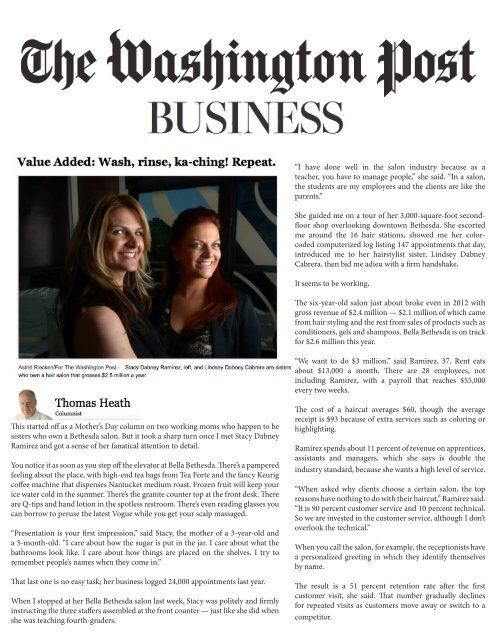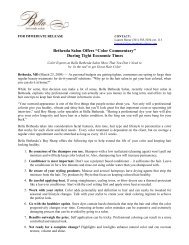Create successful ePaper yourself
Turn your PDF publications into a flip-book with our unique Google optimized e-Paper software.
“I have done well in the salon industry because as a<br />
teacher, you have to manage people,” she said. “In a salon,<br />
the students are my employees and the clients are like the<br />
parents.”<br />
She guided me on a tour of her 3,000-square-foot secondfloor<br />
shop overlooking downtown <strong>Bethesda</strong>. She escorted<br />
me around the 16 hair stations, showed me her colorcoded<br />
computerized log listing 147 appointments that day,<br />
introduced me to her hairstylist sister, Lindsey Dabney<br />
Cabrera, then bid me adieu with a firm handshake.<br />
It seems to be working.<br />
The six-year-old salon just about broke even in 2012 with<br />
gross revenue of $2.4 million — $2.1 million of which came<br />
from hair styling and the rest from sales of products such as<br />
conditioners, gels and shampoos. <strong>Bella</strong> <strong>Bethesda</strong> is on track<br />
for $2.6 million this year.<br />
“We want to do $3 million,” said Ramirez, 37. Rent eats<br />
about $13,000 a month. There are 28 employees, not<br />
including Ramirez, with a payroll that reaches $55,000<br />
every two weeks.<br />
This started off as a Mother’s Day column on two working moms who happen to be<br />
sisters who own a <strong>Bethesda</strong> salon. But it took a sharp turn once I met Stacy Dabney<br />
Ramirez and got a sense of her fanatical attention to detail.<br />
You notice it as soon as you step off the elevator at <strong>Bella</strong> <strong>Bethesda</strong>. There’s a pampered<br />
feeling about the place, with high-end tea bags from Tea Forte and the fancy Keurig<br />
coffee machine that dispenses Nantucket medium roast. Frozen fruit will keep your<br />
ice water cold in the summer. There’s the granite counter top at the front desk. There<br />
are Q-tips and hand lotion in the spotless restroom. There’s even reading glasses you<br />
can borrow to peruse the latest Vogue while you get your scalp massaged.<br />
“Presentation is your first impression,” said Stacy, the mother of a 3-year-old and<br />
a 5-month-old. “I care about how the sugar is put in the jar. I care about what the<br />
bathrooms look like. I care about how things are placed on the shelves. I try to<br />
remember people’s names when they come in.”<br />
That last one is no easy task; her business logged 24,000 appointments last year.<br />
When I stopped at her <strong>Bella</strong> <strong>Bethesda</strong> salon last week, Stacy was politely and firmly<br />
instructing the three staffers assembled at the front counter — just like she did when<br />
she was teaching fourth-graders.<br />
The cost of a haircut averages $60, though the average<br />
receipt is $93 because of extra services such as coloring or<br />
highlighting.<br />
Ramirez spends about 11 percent of revenue on apprentices,<br />
assistants and managers, which she says is double the<br />
industry standard, because she wants a high level of service.<br />
“When asked why clients choose a certain salon, the top<br />
reasons have nothing to do with their haircut,” Ramirez said.<br />
“It is 90 percent customer service and 10 percent technical.<br />
So we are invested in the customer service, although I don’t<br />
overlook the technical.”<br />
When you call the salon, for example, the receptionists have<br />
a personalized greeting in which they identify themselves<br />
by name.<br />
The result is a 51 percent retention rate after the first<br />
customer visit, she said. That number gradually declines<br />
for repeated visits as customers move away or switch to a<br />
competitor.
customer visit, she said. That number gradually declines<br />
for repeated visits as customers move away or switch to a<br />
competitor.<br />
I don’t have much hair to cut, but I spend about $85 a<br />
month, tips included, at a downtown D.C. salon because<br />
it’s close, the receptionist answers the phone fast, it<br />
accommodates me on short notice, I receive prompt,<br />
polite service. Of course, I like the haircut, too.<br />
I have always wondered about the economics of hair<br />
salons, and Stacy filled me in on her place: the hairstylist<br />
and salon split the revenue from each haircut 50-50. They<br />
can run from $16 for a child’s haircut to $700 for a fivehour,<br />
Japanese “straightening” session.<br />
A stylist with a good clientele can earn $100,000 to<br />
$120,000, including tips, in a good year.<br />
Assistants who help manage the salon are paid by the<br />
hour. Ramirez paid herself about $60,000 last year, while<br />
her sister Lindsey earned about $110,000 styling hair.<br />
The company has no debt, so if the sisters can increase<br />
revenue, they might be able to start taking some serious<br />
profit.<br />
Like all smart business owners, one of the sisters is on<br />
the premises nearly every day. Ramirez, who lives in<br />
Howard County, works remotely from home Tuesdays<br />
and Thursdays so she can be with her children. She is at<br />
the salon the rest of the week, including Saturdays, as well<br />
as two Sundays a month. If that’s not enough, she also<br />
helps her husband manage a successful summer day camp<br />
called Outrageous Occasions.<br />
The sisters grew up in Montgomery County in a family<br />
of six children. Lindsey pursued a cosmetology career.<br />
Stacy graduated from a small college in Ohio in 1999 and<br />
became a fourth-grade teacher.<br />
She eventually worked in Montgomery County schools,<br />
where she became frustrated earning a fraction of what<br />
her sister was making as a hairstylist.<br />
A local salon owner who knew Lindsey suggested they<br />
start a salon together. Lindsey’s clientele and reputation<br />
would bring in the clients. Stacy would handle the<br />
business side.<br />
Ramirez said the vast majority of salons lose money. About<br />
15 percent break even and only 5 percent are profitable.<br />
She was determined to be in the 5 percent.<br />
She wanted to create a customer-oriented culture with<br />
good service, a clean shop and communication with the<br />
clients. Where possible, she would train their hair stylists<br />
organically, starting them as shampooists and then, with<br />
Lindsey’s help, turning them into stylists who bought into<br />
the customer-is-first concept.<br />
“Most hair stylists think they can own their own business,”<br />
Ramirez said. “But many stylists need help on the business<br />
side. That’s why Lindsey and I make a great team. Her<br />
strength is hair. My strength is managing and customer<br />
service. I have tried to create that culture.”<br />
To appeal to the widest audience, <strong>Bella</strong> <strong>Bethesda</strong> decided to<br />
be open every day, all day and hire stylists at different points<br />
in their career, so that the salon could accommodate many<br />
budgets.<br />
The sisters also became promoters. They grabbed a blender,<br />
stood on the corner outside and gave ice coffee away to<br />
passersby, urging them to take the elevator to the second<br />
floor and try them out. The sisters joined the <strong>Bethesda</strong>/<br />
Chevy Chase Chamber of Commerce and various network<br />
groups. They talked to everyone they could, trying to get<br />
their story out. They spent $10,000 from savings to build a<br />
Web site.<br />
They built their business, brick by brick. Ramirez would<br />
spend hours with her staff, keeping track of their clients,<br />
advising them on tricks of the trade such as sending<br />
handwritten thank-you notes, tossing in a $5 Starbucks gift<br />
card.<br />
Ramirez knew they were on the right track one Saturday<br />
when the place was so crowded that she had to grab chairs<br />
from the break room to accommodate guests waiting for<br />
their appointment.<br />
The sisters eventually bought out their investor and now<br />
own the salon outright. The only stumble so far was an<br />
embarrassing $30,000 tax bill, which resulted when the<br />
accountant who handled their payroll taxes died suddenly.<br />
Ramirez said <strong>Bella</strong> <strong>Bethesda</strong> is one of the top-grossing hair<br />
salons in the country. About 80 percent of the customers are<br />
women.<br />
Formal occasions like weddings, proms and graduations<br />
bring in a lot of business. To keep the business sharp, she and<br />
Lindsey invested $3,000 in a four-day conference in Tampa<br />
on the salon business.<br />
“Finding time to do everything is the hardest part,” said<br />
Ramirez, who gets up at 6:30 every day. Her head hits the<br />
pillow at 11:30 p.m.<br />
Before she had children, “I didn’t understand why everybody<br />
didn’t work as hard as me.”<br />
Now she gets it.







